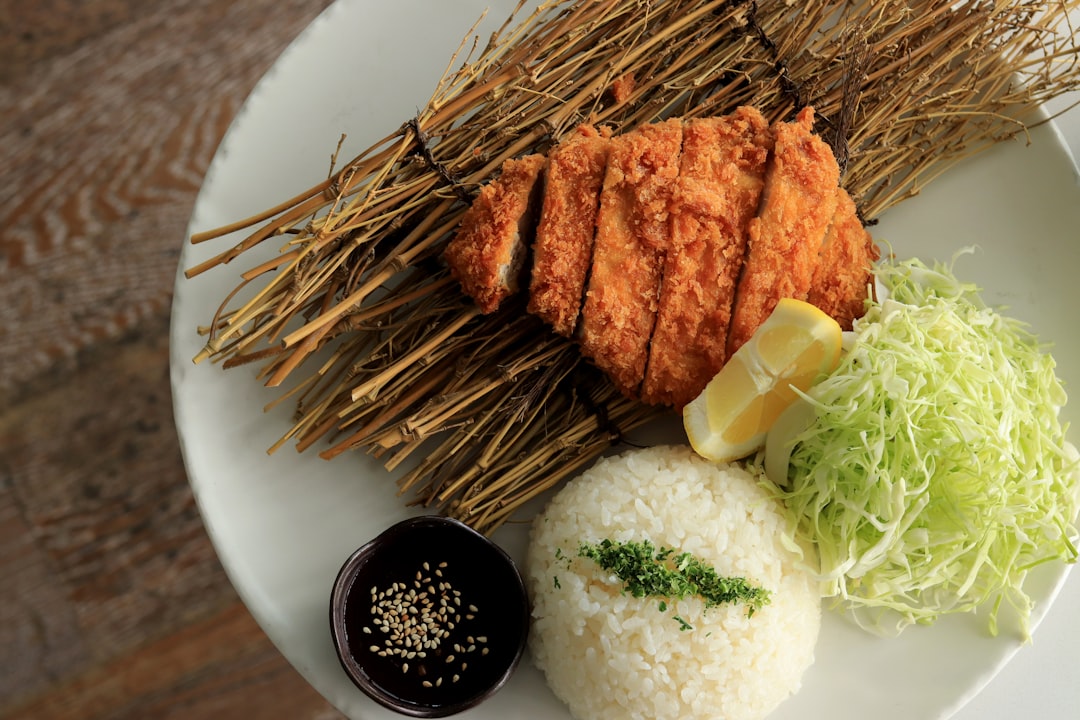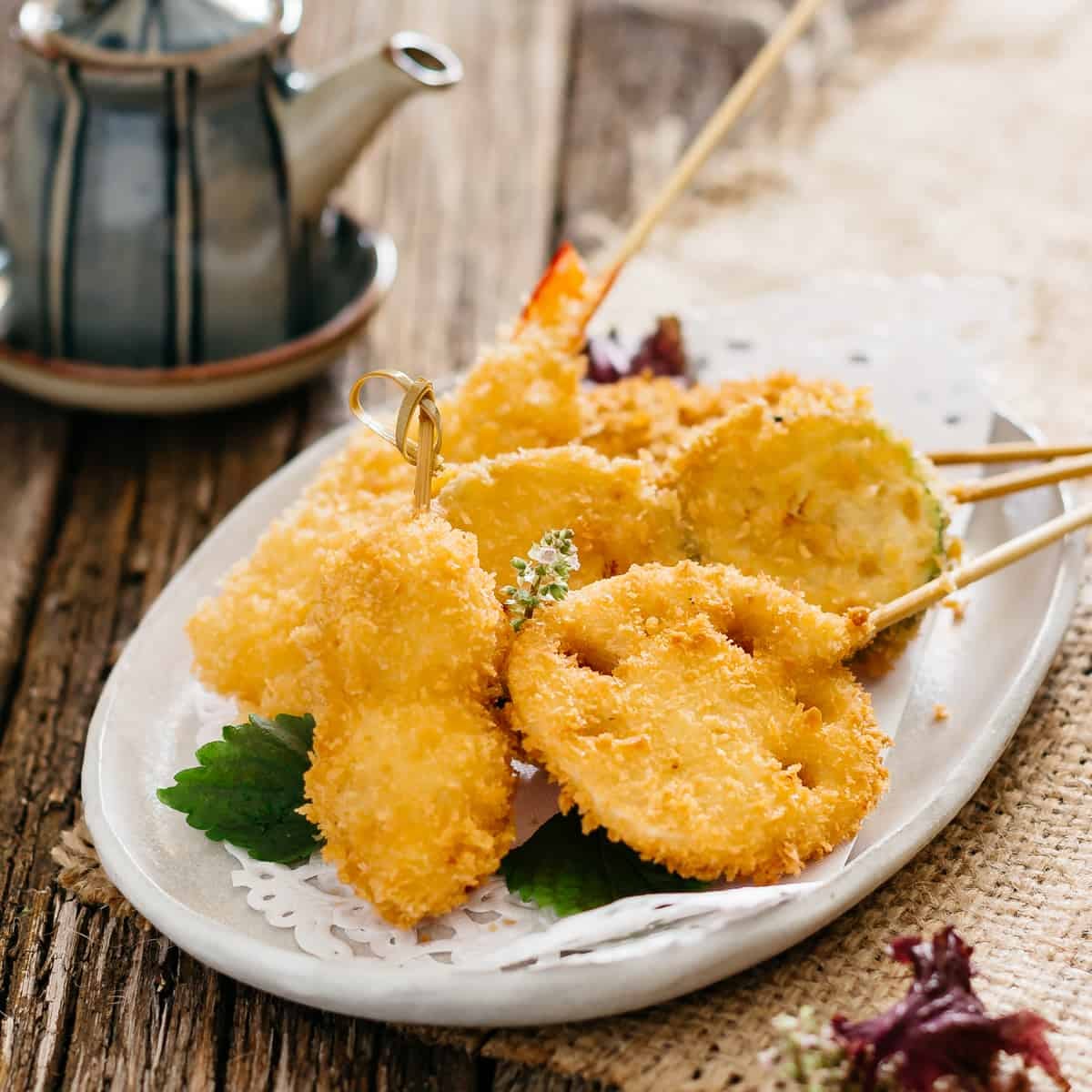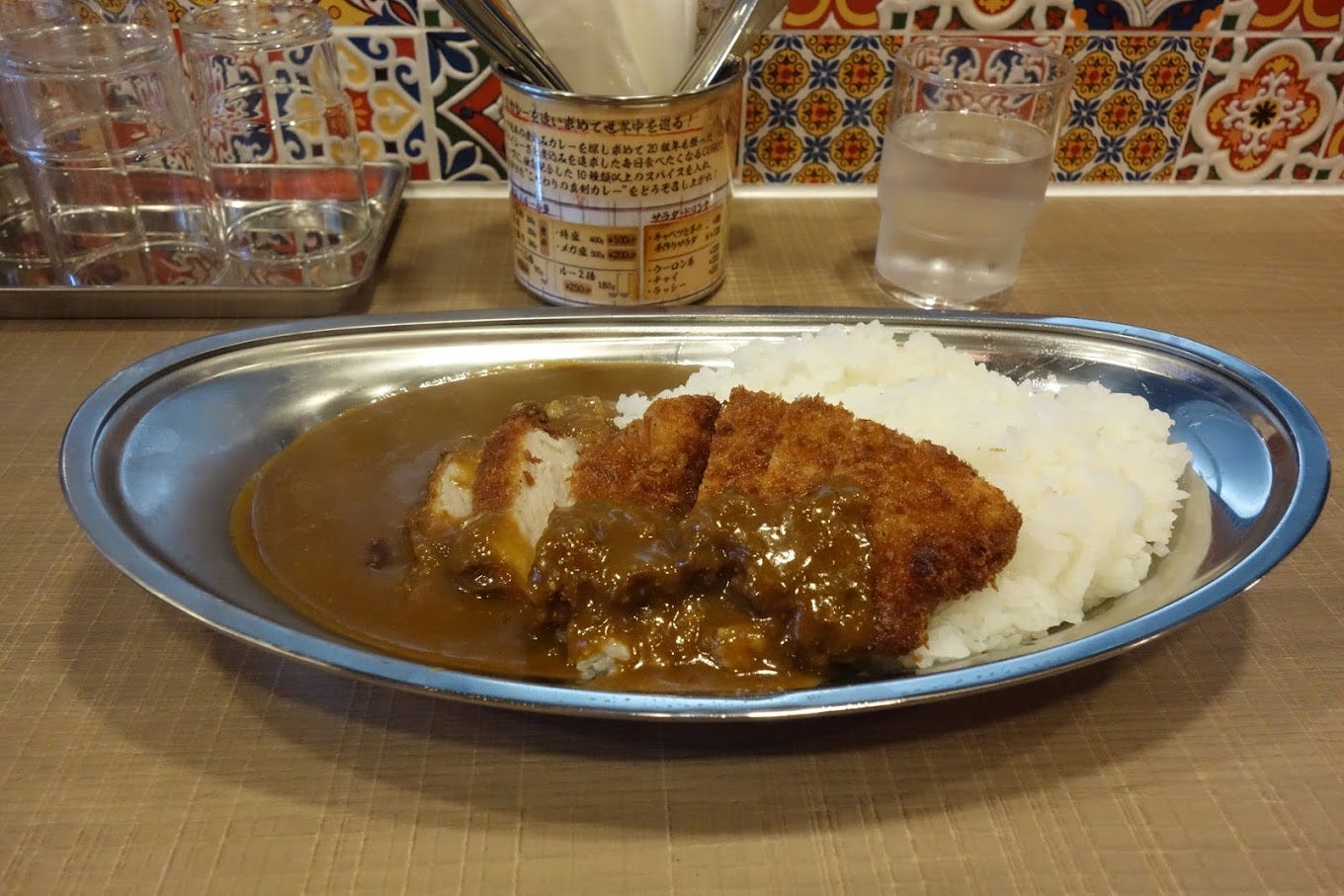Japanese food has a reputation of being focused on tradition. Stories abound of people needing to spend years cooking rice, beating mochi, or cutting fish before qualifying as a “real” chef. What if I told you there was a way to have tasty food and not require decades before being ready to serve it? This post is about the time Japan was taken over by the fast food revolution.
The years Japan spent closed off from the world meant it had to rely on its own traditional ways of making food. These were slow and laborious, and not designed for future generations of industrial workers who had no time to prepare dinner after an unproductive day in the office. The Western Powers chose to knock aggressively at everyone else’s doorsteps in the Meiji period, and it was this unsolicited neighbourly act that allowed the introduction of Western cuisines to Japan.
The final products of this fusion became staples of Japanese food and collectively known as Yoshoku, or Western food. From this style there are three that Japan embraced the most. The three C’s: katsu, curry, and croquettes.
Katsu and Panko
Yes, katsu doesn’t start with C. However, as soon as you try to back translate (find the etymology) of katsu, it was a Japanese transcription of Cutlet, turning into katsuretsu and being shortened to katsu (so technically a C). While a fillet piece of meat being deep-fried just sounds like a schnitzel by another name, a lighter brittle breadcrumb variant called panko makes the difference. It wasn’t a simple case of the Japanese telling breadcrumbs to step aside either; the panko was born out of necessity. When the first schnitzel alighted in Japan they were met with novel delight from diners and dread from restauranteurs, with the high cost of imported breadcrumbs made from crushed biscuits and crackers.
This drove restaurants to look for an alternative as the population demanded more Western food. Experiments abound until someone invented a bread designed for crumbing, a crustless flaky wonder made from white bread. Now breadcrumbs were for everyone and deep fried Yoshoku style food could become the convenient fast food it was destined to be.
Convenience and Comfort
Since katsu has passed from exotic dishes to beloved comfort food for Japan, there would be few places in Japan where you wouldn’t be within walking distance to a ready made katsu meal. Fierce debate rages on regarding which konbini (convenience store) franchise does which katsu the best, so this publication will stay agnostic to avoid crossfire. The one thing I can clearly state is that each store has their own version and it may actually slightly vary depending on the specific location. My point is, if you are in Japan and near civilisation, there will be decent to great katsu available.
If you are looking for the katsus that people go out of their way for, I do want to help guide you. Even for a classic comfort food that’s synonymous with cheap and easy meal, the one constant among Japanese dining is the pursuit of perfection in food. For each katsu style in our guide below, I will highlight a restaurant or stall that is famed among its peers.
Guide to katsus and their sides
Given that katsu is just a breaded deep fried fillet, it comes as no surprise that their selection of fillings is broad. There are so many types of these days it’s hard to know your katsu from your cat soup. Below is a guide to all the variants and details you need to navigate the world of deep fried fillets.
Tonkatsu (Pork):
This is the ‘traditional’ and your standard type of katsu. Consisting of a pork fillet, this is the one you’re sure to encounter any time you visit any restaurant that serves the dish. As the go-to katsu, the tonkatsu shares several accompanying sides you’ll find with ‘variant’ katsus.
Shredded Cabbage:
Perhaps the good-cop sidekick to all of katsu’s bad-cop deep frying. It has been a mainstay of the dish almost since inception; the story goes that at Rengatei (see below) they were short-staffed due to the Russo-Japanese War, so rather than properly cook vegetables they just cut up cabbage and stuck it in cold water.
Later it turned out that people liked the raw cabbage, and have claimed health benefits of lining the stomach with Vitamin U and helping digest an otherwise very heavy meal. While never the headline act, the shredded cabbage generally tours with all katsus.
Tonkatsu Sauce:
The other mainstays are rice (because it’s Japan), and the tonkatsu sauce. Tonkatsu sauce can be thought of as a barbeque sauce with sweet and sour elements. There are two heavyweight industrial producers of Japanese brown sauces, Bulldog and Otafuku. Both have various brown sauces for different meals, with each tonkatsu sauce involving fruits and vegetables to build the sweet and sour stock… but the point of difference comes from their origins.
Bulldog was initially a translation of the UK style Worcestshire Sauce into Japanese flavours, while Otafuku was a conversion of soy sauce into tonkatsu. If you imagine a wine tasting, Bulldog’s sauce specialties are paired better with Yoshoku flavours of katsu, while Otafuku pairs well with Japanese stir-fry dishes specialising in Okonomiyaki and Yakisoba sauces. To my shame, I have mixed and matched sauces despite their subtle differences (and still enjoyed the meal).
The Tonkatsu Originator: Ginza Rengatei 煉瓦亭
Address: 3 Chome-5-16 Ginza, Chuo City, Tokyo 104-0061, Japan
For a dish as ubiquitous as tonkatsu, I guarantee Rengatei isn’t the best in Japan. There might even be better tonkatsu vendors in Ginza, but if you want to go to where it all started for tonkatsu, Rengatei is ground zero. The restaurant has been around since 1895 and has been the inspiration if not inventor of all tonkatsu variations and sides (And also still makes a great dish!)
Torikatsu (Chicken):
Not exactly reinventing the wheel, chicken katsu features a breaded and deep-fried chicken cutlet. It otherwise shares all the same ingredients and preparation with tonkatsu. Where it does have some semblance of personality is the increasing popularity as a sandwich, especially, it seems, overseas. Japan might soon follow in the US’ footsteps of having fried chicken sandwich wars.
Torikatsu Shibuya: The one who cares about cutlet chicken
Address: Japan, 〒150-0043 Tokyo, Shibuya City, Dogenzaka, 2 Chome−16−19 都路ビル 2F
Truth be told, a torikatsu specialist restaurant is rare in Japan. Most katsu establishments may provide the option, but often the choice isn’t pork or chicken, but fatty pork or lean pork. As such, Torikatsu in Shibuya has gained a lot of love for embracing the fried bird.
Gyu-katsu (Beef):
Admittedly, this isn’t the most adventurous variant of the katsu, really just the beef version of the tonkatsu. It is often using this style that you find the very expensive katsu using cuts of Wagyu meat, even Matsusaka (see below for more details) or Kobe Beef.
Here the meat is usually served much rarer, to avoid the texture going all well done. Due to the delicate nature of the meat, it’s often not worth having a Gyu-katsu unless you’re willing to spend for a higher price point.
Sumibiyakiniku Nakahara: The expensive sandwich
Address: Japan, 〒102-0085 Tokyo, Chiyoda City, Rokubancho, 4-3 GEMS市ヶ谷 9F
I don’t mean to focus so much of this in Tokyo, but with a big city comes big excesses. Sumibiyakiniku Nakahara is famous for their incredible gyukatsu sandwich, which features as a part of their ¥ 24,500 meal. Featuring as one of the 50 best restaurants in the world, their gyukatsu sandwich is a key part of its renown.
They’re known as the innovator of using grade 5 wagyu in a humble gyukatsu sandwich (and also as providing the most expensive sandwich in Japan). Their quality might be a double edged sword, with many claiming that once you’ve eaten here, you won’t be able to go back to konbini sandwiches.
Ebi Katsu (Prawn):
Unsurprisingly, Japanese cuisine will feature seafood as an alternative for all styles of cooking. Ebi katsu refers to a prawn or shrimp cutlet that gets butterflied, coated in panko, and then fried. Unlike the previous iterations, ebi katsu is often served with a tangy tartar sauce! The sauce sommeliers of Japan have strict rules insisting on brown meat with brown sauce and white meat with white sauce.
Tartar Sauce:
Another travelling dish, this started as a French sauce that got named after the Eastern European steppe tribes for reasons no one really knows. Like the Western edition, Japan’s tartar sauce is used with seafood. The differences between them can be subtle, primarily stemming from Japanese tartar sauce using Japanese mayonnaise while other countries presumably using their own mayo. Beyond that, Japan likes theirs chunkier, adding to the mix ground boiled egg and the herb shiso, as well as a choose-your-own-adventure selection that can include chopped olives, horseradish, Dijon mustard, vinegar, onions, parsley, or lemon.
Mos Burger: The prawn innovator
Address: Japan, everywhere
Japan's answer to Mickey D’s, this again isn't the best example of Ebi katsu. It does however highlight how Ebikatsu burgers have shaped fast food, creating a whole new product line. Innovations have meant there are limited edition Ebikatsu burgers, with sauce updates and innovative mixed flavours.
Menchi-Katsu:
Menchi katsu is an innovation on the tonkatsu beyond switching meats. Seen as a cheap alternative to a proper meal, the menchi or mince describes the inside patty, typically from ground beef or a mixture of beef and pork. As mentioned with Gyu-katsu, texture and flavour problems can arise when deep frying a piece of cheap steak.
So, by creating a menchi mixture, the butcher can control the fat ratio. Its method of delivery is often not through restaurants, but as a street food with hungry customers queueing outside butchers who sell freshly fried menchi-katsu.
A fun and unverified claim suggests that in the Kansai region it is impolite to ask for menchi by name as it is slang for “glaring for a fight”. Despite this, you’ll be able to find this meal almost anywhere that meat is sold.
Satou: Butcher stylings
Address: 〒180-0004 Tokyo, Musashino, Kichijōji Honchō, 1-chōme−1−8 吉祥寺さとう 2F
Long queues, low prices. The classic butcher style menchi-katsu with accoutrements. This is a butcher that specialises in wagyu from Matsusaka.
This is is a stand in for many others that do a bit of everything, with Satou butcher shop having an upstairs steakhouse restaurant, offering takeaway menchi katsu, and of course regular meat to cook at home. The menchi katsu in particular draws queues starting from an early start, thus landing a place on this list.
Yasai Katsu:
Who says Japan is not good for vegetarians? While it can feel like any vegetable can be made tasty when coated in panko and deep fried, the more common vegetables used for yasai katsu are eggplant, pumpkin, and sweet potato. Luckily no changes to the sides, so it's getting easier for traditional restaurants to serve yasai katsu. There still are many that don't cater to this food requirement, making katsu restaurant finding for a vegetarian a treasure hunt.
Kushikatsu
Not technically under the remit of yasai katsu, it nonetheless is a common way vegetables are delivered in katsu form. Kushi meaning skewers, is a way to katsu simply. Eaten on a stick, it implements a different sauce and usually more daring with what is fried. To enjoy properly, eaters dip the skewers into a communal sauce pot. Naturally this has become a point of great contention, as it’s become another way tourists show themselves as ignorant to the culture via oblivious double dipping.
Yaekatsu: The Endless Varieties
Address: 3 Chome-4-13 Ebisuhigashi, Naniwa Ward, Osaka, 556-0002, Japan
Among the most famous kushikatsu venues in Osaka you can find almost all items being fried on sticks. Beyond the classic meats, seafood and, vegetables, they fry cheeses and fruits, offering your classic picnic spread interpreted through a deep fryer.
Miso Katsu
For the purposes of this article, miso katsu also is representative of a stand-in for all regional variants. To be fair, this is really just a tonkatsu with another sauce. As one of Nagoya’s signature dishes, it has become a point of pride for some residents who insist you try the local flavour. To be fair, I believe miso katsu is the most famous of the mildly altered tonkatsu, but in my honest opinion doesn’t change too much. If you haven’t guessed already, it uses a miso based sauce (hacchoumiso) instead of the traditional sweeter tonkatsu sauce.
Misokatsu Yabaton: The Legend in Nagoya
Address: 3 Chome-6-18 Osu, Naka Ward, Nagoya, Aichi 460-0011, Japan
I’ve listed one of this local chain’s addresses but it’s a restaurant that you can find anywhere in Nagoya. Founded in 1947, Yabaton is the place most residents will suggest trying the famous dark sauce. Despite everyone’s love of the miso sauce, their most popular dish the half/half keeps half of the tonkatsu with the classic tonkatsu sauce.
It is worth noting they have become a nation wide chain due to their high quality meat, so you can even find Misokatsu Yabaton at Tokyo Haneda Airport.
Katsu Curry
Combining two of the Yoshoku favourite dishes, this might be the most ambitious crossover ever! I won’t delve too deep into the curry aspect (keep reading next week), but the concept is to add curry to katsu. It has been an unmitigated success and often restaurants specialise in this dish specifically.
Maji Curry: Mayor of Curry town
Address: Japan, 〒101-0052 Tokyo, Chiyoda City, Kanda Ogawamachi, 3 Chome−1-0-7
The most recent entrant on this list, this is a restaurant that has succeeded in a very crowded field. For context, according to their own website, starting this restaurant was “a bold move, considering the Kanda area houses more than 400 curry restaurants.” Now they hold resident-voted championship titles from 2018 and 2022. They also seem to be expanding both nationally and abroad, so you might get a visit from Maji soon. Read more next time on why curry is so Japanese.
I hope this exhaustive list helps you figure out what katsu you want and give some flavour to where you want to go for a different experience. Keep reading Hidden Japan for the next entry in the Yoshoku Trilogy.








I'm the fool who voted for schnitzel, but only because I haven't eaten katsu yet.
If I get within a block of a place that serves them tho', I will be wolfing down as many types as they have, now that I've read this. Thanks!
Japan also got influenced by european cuisine after the first contact with the Portuguese resulting in dishes like pam and tempura.